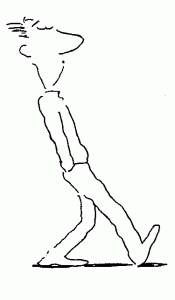Walking is a great form of exercise. It’s easily accessible. No special equipment needed. And it’s also a great place to work on improving your posture and movement.
How did you learn how to walk? I don’t remember taking my first step. Not surprising since most of us don’t start storing memories until we’re about three years old. And if I was anything like the toddlers I see now taking their first steps, I probably didn’t spend much time walking—because as soon as I could run, that was so much better. Why walk, when you can run?
So probably nobody taught you how to walk. But it’s never too late to learn how to make your walking more efficient and easier on your body.
Below are four simple tips to explore. Work on one at a time. Try not to exaggerate the instructions—subtlety is the key. None of these tips are meant to cause you to walk strangely or uncomfortably.
1) Head Up Eyes Forward
It may seem obvious, but remember to look where you’re going. If you walk around looking down, it’ll cause you to drop not only your head but also your neck forward of your body. The weight of your head (10-12 lbs) falling too far forward and down throws you off balance and puts a strain on your neck, upper back, and shoulders.

Simply reminding yourself to look out in front of you and enjoy looking at your surroundings will facilitate a better relationship between your head and spine. If you need to look down while you’re walking use the pivoting action at the nodding joint high up between your ears and look down from higher up.
2) Stay Off Your Legs
We too often sink or sit down on our hips or legs when walking.
 Find your hip joints by marching in place and finding the crease that your leg makes with your body in the front. From there down are your legs. Think of the upper body, including your pelvis, easing upward off your legs as you walk. And walk tall.
Find your hip joints by marching in place and finding the crease that your leg makes with your body in the front. From there down are your legs. Think of the upper body, including your pelvis, easing upward off your legs as you walk. And walk tall.
3) Don’t Reach Out
When you want to walk faster what do you do? Do you lengthen your stride by reaching out further in front of you as you walk? If you do, you’re in good company. But overstriding (reaching out in front of the body with your lead foot) is problematic for a few reasons.

- It’s basic physics. If you place your foot down in front of your center of gravity as you walk you create a brake on your forward movement. It’ll slow you down.
- If you’re locking your knee as you reach out with the lead foot, the knee will be less able to absorb shock and it will be jarring. Pain can result.
- Reaching out too far in front of you can also be a dangerous way to walk, especially in the winter when it’s icy. If you live in a cold climate, you’re familiar with “the penguin walk” to prevent slipping on the ice. Looks silly, but not if it keeps you upright.
- Lastly, when you overstride in front it often causes you to lean back or sit on your hips instead of walking tall.
There are two ways you can go faster. Take bigger steps or increase your step rate. If you want to go faster, explore taking more steps per minute (increasing your cadence) and keeping your stride length the same instead of trying to lengthen your stride by reaching out in front.
If you do want to lengthen your stride, try lengthening it behind you instead of in front of you. Explore keeping the heel of your trailing leg on the ground a split second longer before you pick your foot up. You want to end up rolling through your trailing foot and pushing off the ball of the foot and the big toe. Let that action power you forward.
4) Be Here Not There
I’ve saved the most important for last. It has to do with your mindset. Do this little exercise first.
Imagine you’re driving in your car somewhere, with all the time in the world. No worries that you’re going to be late for an appointment. No traffic. You can enjoy your drive. Enjoy the scenery. Just be in the moment.
How does your body feel?
Now, imagine you’ve just left your house 10 minutes later than you’d planned to. You’ve got to make an important appointment across town. In normal traffic, it takes 30 minutes. You pull on the interstate and it’s bumper to bumper. Shoot! You forgot your phone on the kitchen table. No way to text to let them know you’re running late.
How does your body feel?
If your body feels different in the two scenarios you’ve experienced the difference between a mindset of “being here” vs “being there”. Your mindset does affect your muscles. If your body feels more tense in the second scenario above try using that information to your advantage when you’re out walking. Practice “being here” as you walk.
The best way I know how to practice “being here” is to simply notice your feet on the ground every so often and give yourself time to take a walk. Instead of focusing on getting it done or what you’re going to do next. Try it. Your body will probably like you better for it.
Can you read body language? Is this guy “here” or already “there”?

Do you walk for exercise? Do you ever think about walking when you walk?
Photo Shutterstock.com; cartoons used with permission of DIRECTION Journal.




